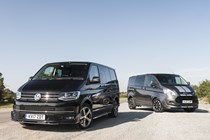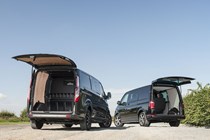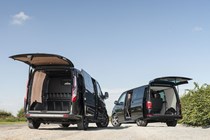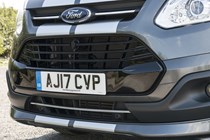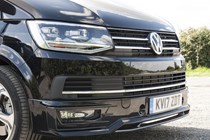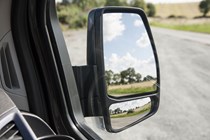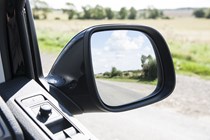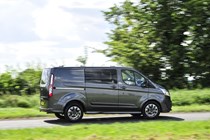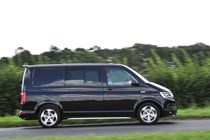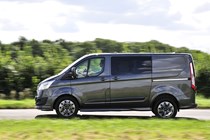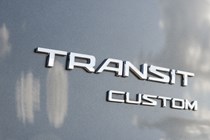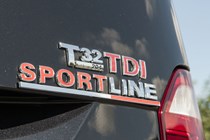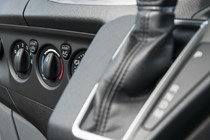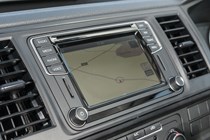Let’s not muck about – here we have a twin-test review of two of the most popular and exciting mid-size sport vans on the market: the Ford Transit Custom Sport Van and the Volkswagen Transporter Sportline.
Designed to appeal to businesses and lifestyle buyers alike, these sporty medium vans come with beefed-up bodywork on the outside – which makes them, and your business, stand out from the crowd – plus posher cabs to keep people more than usually comfortable on the inside.
On top of this they also feature upgraded suspension, intended to make them drive better and look even sharper.
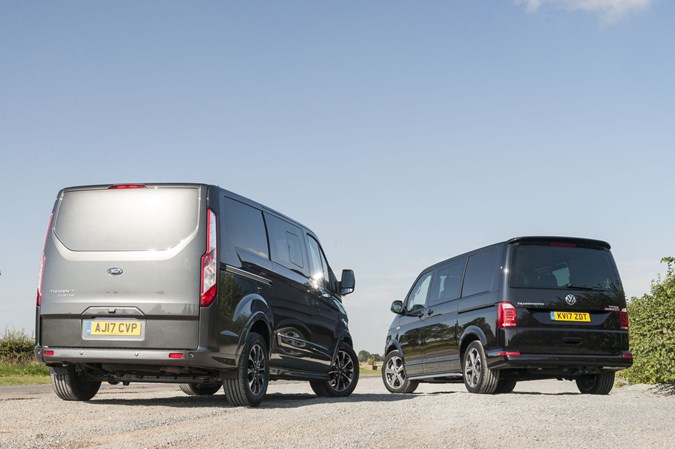
Tested here as a Transit Custom Sport DCiV (that’s Double Cab-in-Van) and a Transporter kombi, both come with a second row of seats, too, giving them the potential to function as family or recreational vehicles, as well as light commercial ones.
And what’s more, both sit at the top of their respective ranges, offering the most powerful engine available in combination with an automatic gearbox – meaning maximum performance and ease of use.
But which is best? Let’s find out.
VW Transporter Sportline vs Ford Transit Custom Sport – is it a fair fight?
While both of these vans are range-topping models, we have to admit they aren’t quite the same.
The first difference is useful for deciding what sort of multi-seater van will best suit your needs.

This Transit Custom DCiV has five seats – two in the front row, three in the second row – and more significantly, a full, fixed bulkhead. The Transporter Sportline kombi, however, has no fixed bulkhead, and six seats – three in the front, three in the back.
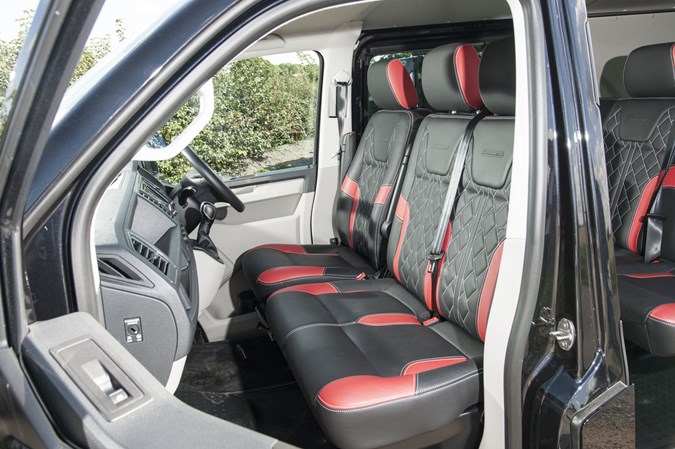
Putting aside the number of people each can carry, the Ford’s advantages in having a fixed bulkhead are increased safety and reduced road noise. The VW alternatively offers extra load flexibility – not only can longer items go under the rear seats, these seats can be removed entirely if required, leaving a vastly larger load space.
The second difference is the Transporter’s inescapable performance lead. Ford’s 2.0-litre TDCi EcoBlue diesel engine currently tops out at 170hp from the factory – whereas VW offers a monstrous 204hp 2.0-litre TDI diesel in the Transporter, which suits the character of the Sportline perfectly.
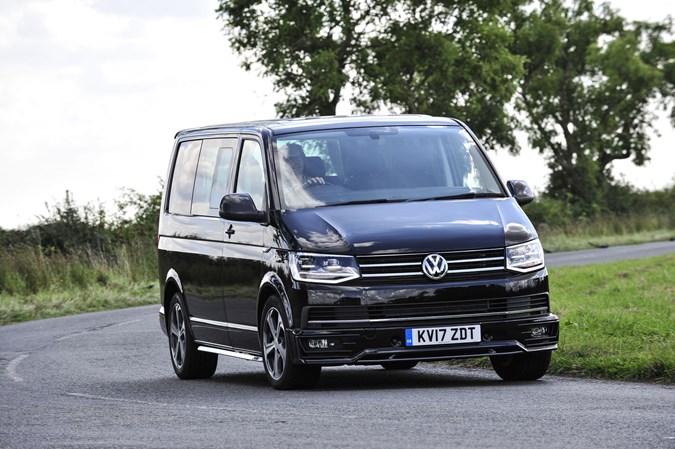
This also results in a bit of a price difference – as tested with their optional automatic gearboxes, the VW Transporter Sportline kombi comes in at £36,845 to the Ford Transit Custom Sport DCiV’s £32,390 (both excluding VAT and options).
208hp Ford Transit Custom R-Spec review
Ford Transit Custom Sport vs VW Transporter Sportline – which is better to drive?
Both manufacturers have made an effort to improve the driving experience for these particular models, though Ford not only matches VW’s lowered suspension but also adds an anti-roll bar to the rear and a thicker front anti-roll bar compared to the standard Transit Custom.
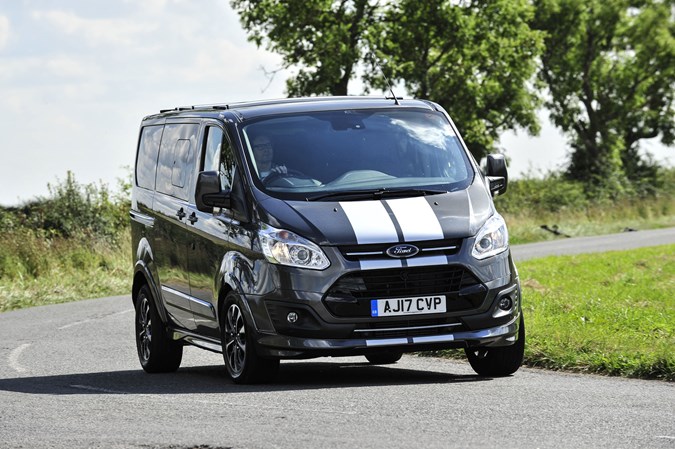
As far as their respective standard versions go, the Transit Custom is typically a more engaging van to drive than the Transporter, with keener, more detailed steering and well-controlled body roll in the corners.
But the Ford suffers badly with a bouncy ride – and the upgrades to the Sport do nothing to help this problem. In fact, it’s rather irritable, and instead of absorbing sudden lumps in the road it seems to climb them. You also get a disconcerting lateral rocking motion when turning quickly, too.
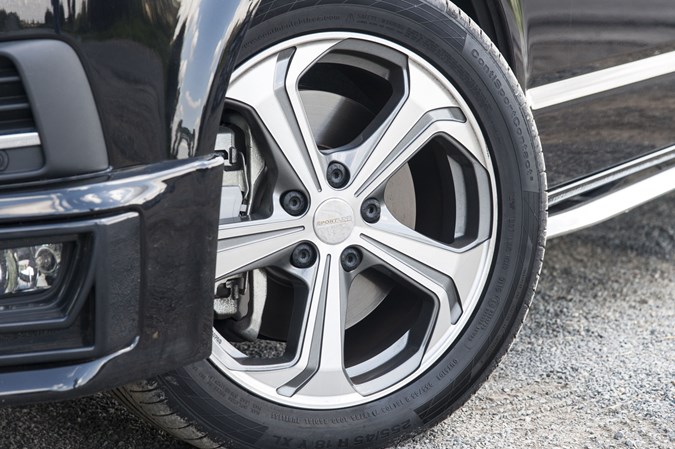
So while the Transporter Sportline still has the slightly lazy steering of its more ordinary siblings, and a pronounced, predictable tendency towards washing wide if you’re too heavy with your right foot in the corners, the better job it does dealing with bumpy surfaces means it’s easier to make the most of its performance.
This despite the VW wearing large 18-inch alloy wheels versus the Ford’s rather chintzy 17-inch rims.
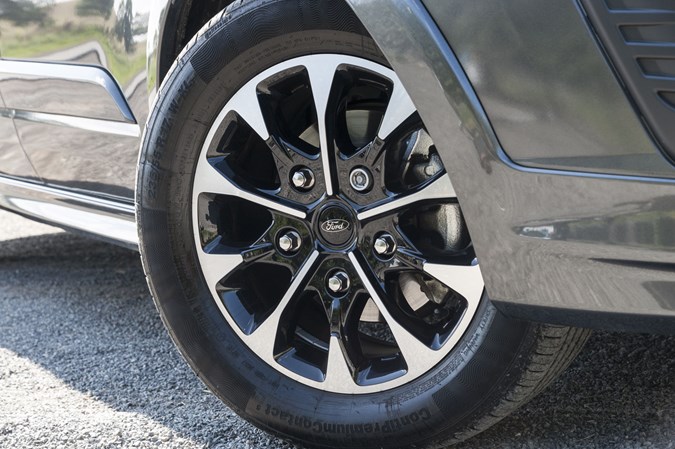
It’s also impossible to ignore the Transporter’s superior engine and gearbox combination. The Transit Custom feels quick enough in isolation, but the very immediacy of the Ford’s engine often makes it feel jerky – a situation that’s not helped by the six-speed automatic transmission.
Put your foot down on the move, and there’s a pause, before – bang – the downchange comes in and you get a sudden, often unwelcome, surge of acceleration. It makes the Ford difficult to drive smoothly.
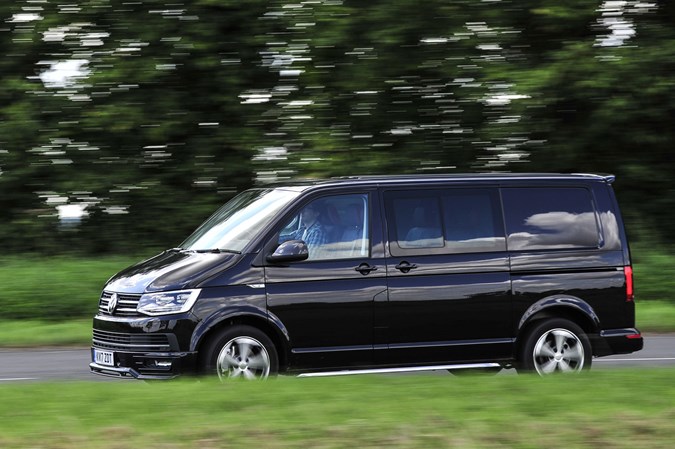
The VW has big-hearted boost at seemingly any speed, not only making it faster but smoother. The more advanced technology in VW’s twin-clutch DSG automatic gives you seven speeds for better acceleration and fuel economy, while also shifting more quickly and with greater composure.
The result is a properly fast van – 0-62mph takes just 9.2 seconds – so long as you don’t get too carried away in the corners.
VW Transporter Sportline vs Ford Transit Custom Sport – which is better inside?
Some curious contrasts here. The Transporter has extremely fancy upholstery, with diamond-quilted leather seats and lots of red highlighting – but it’s as if VW couldn’t be bothered to finish trimming the rear of the cabin, leaving everything looking a little aftermarket.
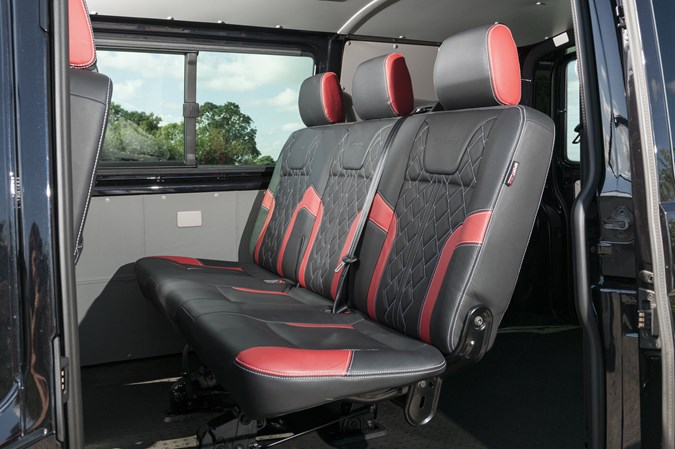
The Ford is fully trimmed in the rear up to the bulkhead, and its seats aren’t bad either. But it feels comparatively claustrophobic inside, and from a practical perspective, whoever decided to put the air-conditioning controls on the other side of the gearlever should be shot.
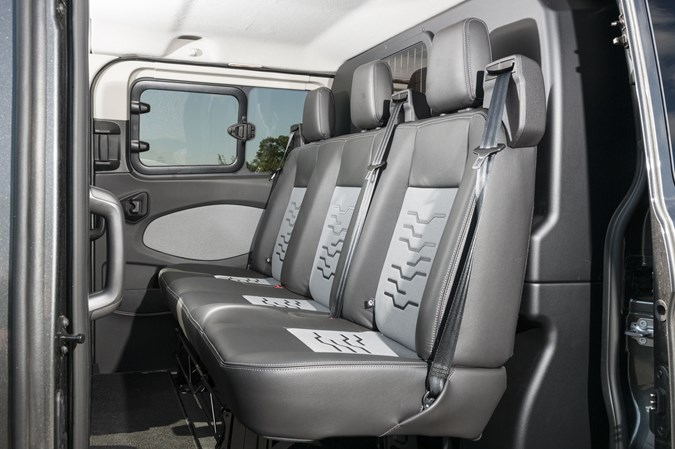
That gearlever is annoyingly designed in such a manner that you always tend to put the van into manual mode rather than automatic drive, too.
There’s also far less useful storage in the Transit’s cab, with the Transporter not only brimming with cubbies and cupholders but with far handier front door pockets as well.
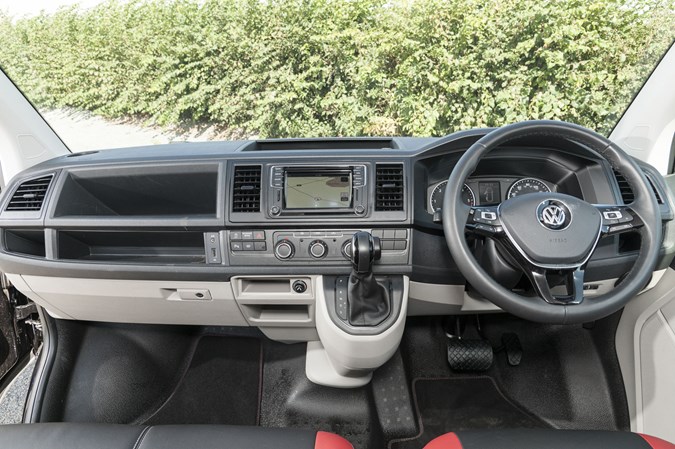
VW just seems to be much better at basic ergonomics. The controls are all sensibly placed, the infotainment system is far more user-friendly than Ford’s tiny-screened and clunkily-controlled effort, and the driving position is nice and high with plenty of adjustability.

It is rather tight that VW only gives you a single sliding side door for access to the rear passenger area – a second is optional (as is power operation, if you want it). The Ford comes with two manual sliding side doors as standard.
Ford Transit Custom Sport vs VW Transporter Sportline – which is better on a long journey?
Before you start to conclude the VW is running away with things here, time to meet the Transporter’s Achilles’ heel: road noise.
This van is massively, massively loud inside. The din doesn’t come from the engine – that actually sounds quite appealing when it’s on boost – but the sound of the van driving over the road. All Transporters suffer from this to a certain extent, but the Sportline kombi is particularly awful.
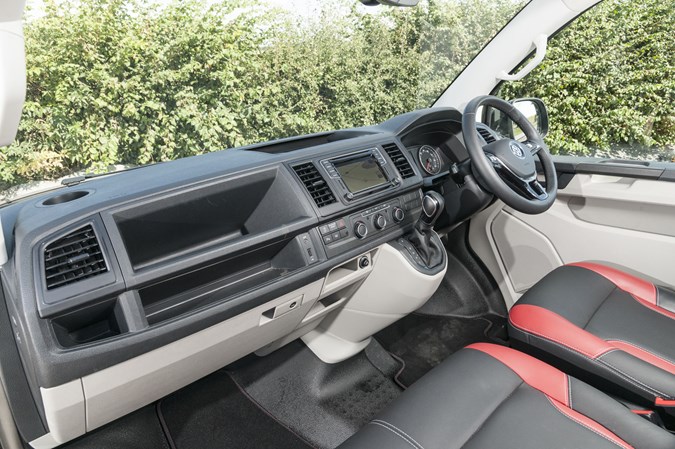
The problem is two-fold: having no bulkhead, which means the large open area inside the van serves to amplify the noise; and the Sportline’s large wheels, which generate more roar in the first place. Seriously, you’ll be longing for earplugs, or feel the need to turn the radio up to near deafening volume to compete.
By contrast, the Ford, with its fixed bulkhead and more fully trimmed interior, is impressively quiet on the move – making for a much more pleasant long distance experience provided you can put up with the bumpier ride quality.
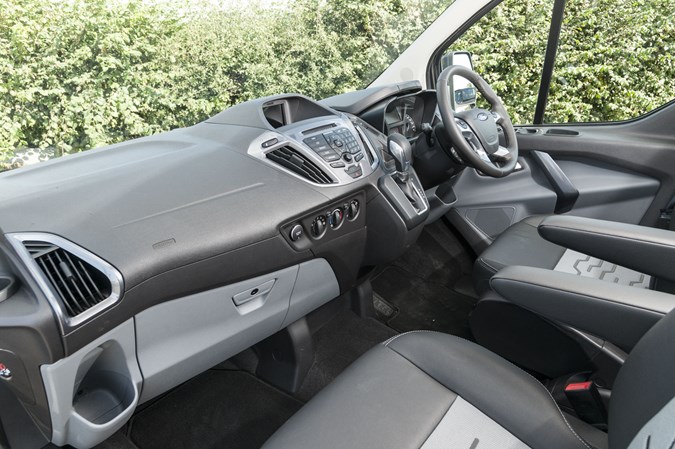
Neither of these vans has particularly great seats when it comes to comfort, however. So if you’re regularly pounding up and down motorways for hours at a time, you might be better off with a high-spec Mercedes Vito…
VW Transporter Sportline vs Ford Transit Custom Sport – which has the better load area and payload?
Both vans tested here are in their smaller, short-wheelbase (SWB, or L1, as Ford puts it) configurations. This gives them the following load area dimensions.
Ford Transit Custom Sport L1 DCiV load area dimensions:
- Maximum load length: 1,577mm
- Maximum load height: 1,406mm
- Maximum load width: 1,775mm
- Width between the wheelarches: 1,390mm
- Maximum load volume: 3.5 cubic metres
- Payload: 1,012kg
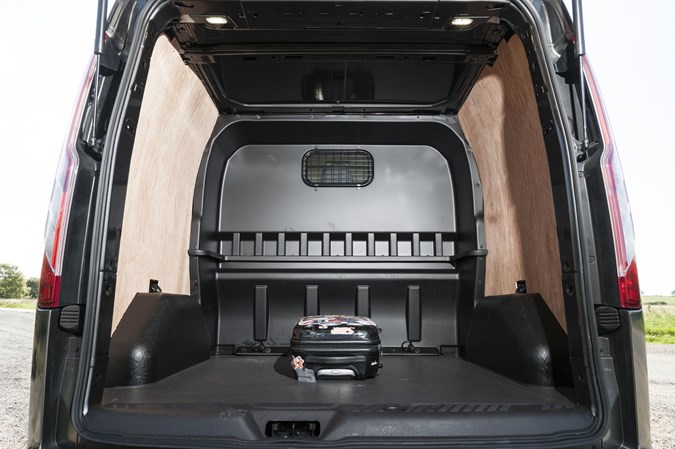
VW Transporter Sportline (SWB) kombi load area dimensions:
- Maximum load length: 2,572mm
- Load length behind the rear seats: 1,600mm
- Maximum load height: 1,397mm
- Maximum load width: 1,627mm
- Width between the wheelarches: 1,244mm
- Maximum load volume: 5.8 cubic metres (with rear seats removed)
- Payload: 1,029kg
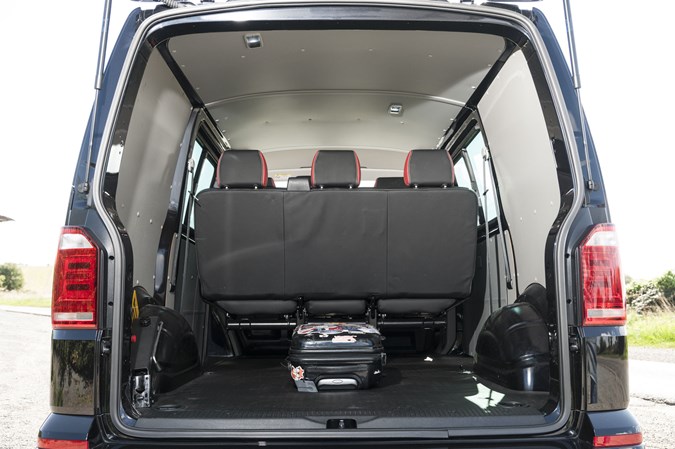
As you can see, there’s not a great deal between the two when it comes to load capacity – accepting the added versatility of the Transporter kombi’s removable rear seats.
The lack of rear bulkhead will make carrying especially heavy loads more dangerous in the VW, however, so invest in some high-quality tie-down straps…
Note, you can get the Transit Custom as a combi with no bulkhead and up to three rows of seats. But you can’t get a Transporter with more than one row of seats and a bulkhead.
Ford Transit Custom Sport vs VW Transporter Sportline – standard equipment and value
Both these vans represent the most expensive options in their ranges, and for that money you get plenty of kit included.
Ford Transit Custom Sport Van DCiV standard equipment highlights:
- Sport Van bodykit, including front and rear bumper skirts, side skirts, wheelarch extensions and stripes
- 17-inch alloy wheels
- Sport Van suspension
- Partial leather trim
- Ford Sync media system with 4.0-inch screen, Bluetooth, DAB radio, USB connectivity and four speakers
- Upgraded instrument cluster
- Rear-view camera with trailer hitch assist
- Front and rear parking sensors
- Twin sliding rear side doors
- Heated front seats
- Air-conditioning
- Power-folding electric door mirrors
- Automatic lights and wipers
- Cruise control with speed limiter
- Heated windscreen
- Eight-way adjustable driver’s seat
- Thatcham Category 1 alarm
- Driver and passenger airbags
- Electronic stability control
- Lane keeping alert (lane departure warning)
- Tyre pressure monitoring
VW Transporter Sportline kombi standard equipment highlights:
- Sportline exterior upgrade, including front bumper spoiler, side bars with puddle lights, rear roof spoiler, carbonfibre door mirror covers
- 18-inch alloy wheels
- Lowered suspension
- Quilted leather seats finished in red and black
- Glazed tailgate with heated screen and wiper (kombi only)
- Discovery media system with 6.33-inch touchscreen, sat-nav, DAB radio, Bluetooth, USB connectivity, aux-in, SD card slot, four speakers
- Rear parking sensors
- Single sliding rear side door
- Climatic air-conditioning
- Electric, heated door mirrors
- Automatic lights
- Cruise control
- Heated windscreen
- Auto-dimming rear-view mirror
- Thatcham Category 1 alarm
- Driver and passenger airbag
- Electronic stability control
- Electronic differential lock (for enhanced traction)
- Front assist with city emergency braking (autonomous emergency braking)
- Automatic post-collision braking (stops the van after a crash to prevent further impact)
- Hill hold assist
The more expensive Transporter does include sat-nav as standard, whereas it remains an option on the Ford. The VW also has a more extensive range of standard safety equipment (which is far less prone to making annoying beeping noises than the optional gear on the Ford).
VW Transporter Sportline vs Ford Transit Custom Sport – running costs
Both vans come with a three-year warranty.
The Transit Custom’s servicing intervals are far longer at 36,000 miles or two years, but both offer guidance on when a service is required via the trip computer, and Ford has been experiencing some problems with early oil change requests with this engine.
The VW has the fuel economy advantage – in this spec with the 204hp engine and seven-speed DSG transmission it returns a claimed 42.8mpg, which is marginally better than the manual gearbox equivalent.
The 170hp Ford with the six-speed automatic manages only 39.8mpg, which is less than the manual, and because it uses older technology also likely to be worse in the real world.
The VW is also likely to hold its value better, meaning you’ll recoup more of the purchase price when you come to change it.
Ford Transit Custom Sport vs VW Transporter Sportline – verdict
If money is no object, our choice here is clear – the Transporter Sportline is faster, better to drive, has the more intelligently designed cab and even promises to be cheaper to run. The quality of materials up-front is higher, too, and you get more safety equipment as standard.
Yet it’s not perfect. The rear seat area looks unfinished in comparison to the Ford, and the lack of a rear bulkhead – even as an option – means it won’t be suitable for everyone. VW really does need to do something about the road noise. We could live with that, but only just.
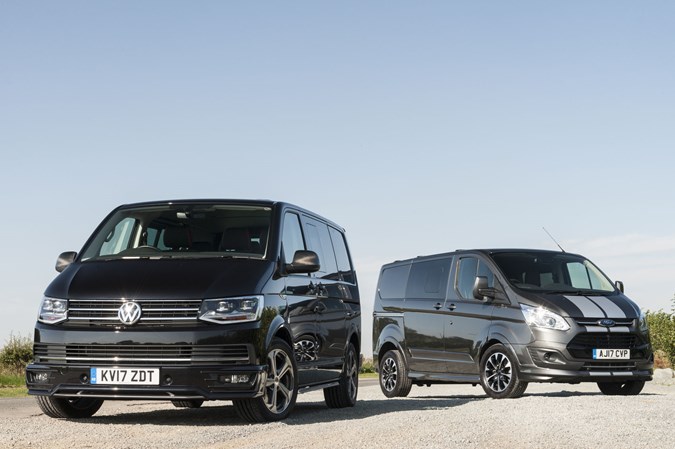
It’s also not game over for the Ford, as the Transit Custom is about to receive an extensive mid-life upgrade – we drive this in November 2017 ahead of it going on sale in early 2018. We can’t wait to host the rematch.
Also read:
208hp Ford Transit Custom MS-RT R-Spec review
Ford Transit Custom 2018 facelift – full details
VW introduces new petrol-powered Transporter TSI models with up to 204hp
Just so you know, we may receive a commission or other compensation from the links on this website - read why you should trust us.



